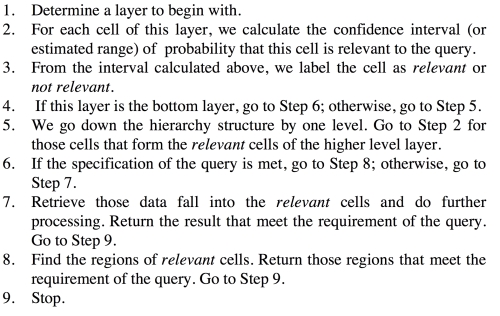 Recommendation system and STING
by Richard Heimann, Nathan Danneman, Pradeepta Mishra, Bater Makhabel
R: Mining Spatial, Text, Web, and Social Media Data
Recommendation system and STING
by Richard Heimann, Nathan Danneman, Pradeepta Mishra, Bater Makhabel
R: Mining Spatial, Text, Web, and Social Media Data
- R: Mining Spatial, Text, Web, and Social Media Data
- Table of Contents
- R: Mining Spatial, Text, Web, and Social Media Data
- R: Mining Spatial, Text, Web, and Social Media Data
- Credits
- Preface
- 1. Module 1
- 1. Warming Up
- 2. Mining Frequent Patterns, Associations, and Correlations
- An overview of associations and patterns
- Market basket analysis
- Hybrid association rules mining
- Mining sequence dataset
- The R implementation
- High-performance algorithms
- Time for action
- Summary
- 3. Classification
- Classification
- Generic decision tree induction
- High-value credit card customers classification using ID3
- Web spam detection using C4.5
- Web key resource page judgment using CART
- Trojan traffic identification method and Bayes classification
- Identify spam e-mail and Naïve Bayes classification
- Rule-based classification of player types in computer games and rule-based classification
- Time for action
- Summary
- 4. Advanced Classification
- 5. Cluster Analysis
- 6. Advanced Cluster Analysis
- Customer categorization analysis of e-commerce and DBSCAN
- Clustering web pages and OPTICS
- Visitor analysis in the browser cache and DENCLUE
- Recommendation system and STING
- Web sentiment analysis and CLIQUE
- Opinion mining and WAVE clustering
- User search intent and the EM algorithm
- Customer purchase data analysis and clustering high-dimensional data
- SNS and clustering graph and network data
- Time for action
- Summary
- 7. Outlier Detection
- Credit card fraud detection and statistical methods
- Activity monitoring – the detection of fraud involving mobile phones and proximity-based methods
- Intrusion detection and density-based methods
- Intrusion detection and clustering-based methods
- Monitoring the performance of the web server and classification-based methods
- Detecting novelty in text, topic detection, and mining contextual outliers
- Collective outliers on spatial data
- Outlier detection in high-dimensional data
- Time for action
- Summary
- 8. Mining Stream, Time-series, and Sequence Data
- 9. Graph Mining and Network Analysis
- 10. Mining Text and Web Data
- A. Algorithms and Data Structures
- 2. Module 2
- 1. Data Manipulation Using In-built R Data
- What is data mining?
- Introduction to the R programming language
- Data type conversion
- Sorting and merging dataframes
- Indexing or subsetting dataframes
- Date and time formatting
- Creating new functions
- Loop concepts - the for loop
- Loop concepts - the repeat loop
- Loop concepts - while conditions
- Apply concepts
- String manipulation
- NA and missing value management
- Missing value imputation techniques
- Summary
- 2. Exploratory Data Analysis with Automobile Data
- Univariate data analysis
- Bivariate analysis
- Multivariate analysis
- Understanding distributions and transformation
- Interpreting distributions
- Variable binning or discretizing continuous data
- Contingency tables, bivariate statistics, and checking for data normality
- Hypothesis testing
- Non-parametric methods
- Summary
- 3. Visualize Diamond Dataset
- 4. Regression with Automobile Data
- 5. Market Basket Analysis with Groceries Data
- 6. Clustering with E-commerce Data
- 7. Building a Retail Recommendation Engine
- 8. Dimensionality Reduction
- 9. Applying Neural Network to Healthcare Data
- 1. Data Manipulation Using In-built R Data
- 3. Module 3
- 1. Going Viral
- 2. Getting Started with R
- 3. Mining Twitter with R
- 4. Potentials and Pitfalls of Social Media Data
- 5. Social Media Mining – Fundamentals
- Key concepts of social media mining
- Good data versus bad data
- Understanding sentiments
- Sentiment polarity – data and classification
- Supervised social media mining – lexicon-based sentiment
- Supervised social media mining – Naive Bayes classifiers
- Unsupervised social media mining – Item Response Theory for text scaling
- Summary
- 6. Social Media Mining – Case Studies
- A. Conclusions and Next Steps
- Bibliography
- Index
STatistical Information Grid (STING) is a grid-based clustering algorithm. The dataset is recursively divided into a hierarchy structure. The whole input dataset serves as the root node in the hierarchy structure. Each cell/unit in a layer is composed of a couple of cells/units in the lower layer. An example is shown in the following diagram:

To support the query for a dataset, the statistical information of each unit is calculated in advance for further processing; this information is also called statistics parameters.
The characteristics of STING algorithms are (but not limited to) the following:
- A query-independent structure
- Intrinsically parallelizable
- Efficiency
Please take a look at the R codes file ch_06_sting.R from the bundle of R codes for the previously mentioned algorithm. The codes can be tested with the following command:
> source("ch_06_sting.R")
Depending on statistical, data-mining, and knowledge-discovery techniques, recommendation systems are being used by most of the e-commerce sites to make it easy for consumers to find products to purchase. Three main parts: representation of input data, neighborhood formation, and recommendation generation are shown in the following diagram:

-
No Comment
